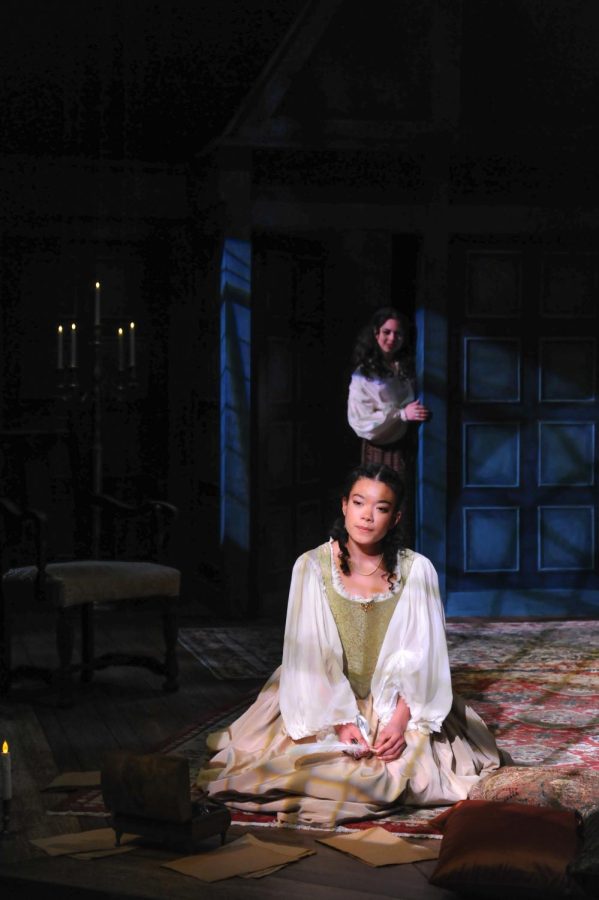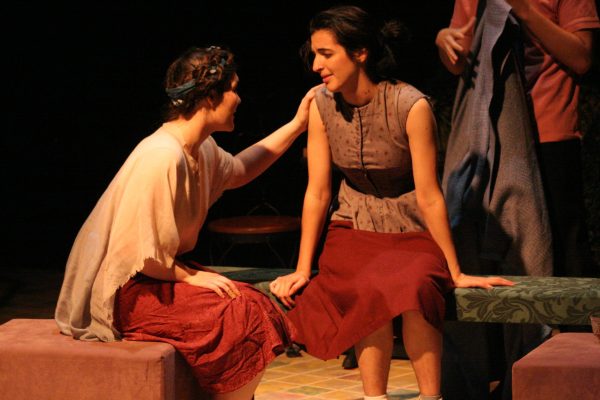Oberlin Theater Presents Or, Brings Hilarity to Campus
The intricate set, characterized by contrasting blues and oranges, pillows, rugs, and a candelabra, as well as dramatic lighting that casts dark shadows on the floor, is almost enough on its own to make Or, a worthwhile way to spend this weekend. However, the fast-paced and witty play of espionage and eccentricity in Restoration-era England by playwright Liz Duffy Adams has plenty more at its disposal to draw you in and capture your attention.
The production, directed by Associate Professor of Theater and Costume Designer Chris Flaharty, runs Dec. 8, 9, and 10 at 7:30 p.m. and Dec. 10 and 11 at 2 p.m. in the Irene and Alan Wurtzel Theater. Immersion into the set begins immediately, with the first scene opening mere feet from the front row.
The play commences with a breaking of the fourth wall, where soon-to-be-revealed protagonist Aphra Behn (College fourth-year Anire Kim Amoda), a historical playwright and prose writer from the era portrayed, enters to tell the audience with a certain grandiloquence to silence their phones and locate the exit signs, all while musing upon whether this is a production of “lust or love,” “cheap hackney art or trash.”
Though I was initially skeptical of the mixture of contemporary and 1600s English, the effect ultimately made for a tremendously engaging viewing experience courtesy of Adams’ mastery of vocabulary and the actors’ skillful delivery. However, it was still jarring at times, generally not because of the strong language and topics discussed but rather the stark juxtaposition between conversations of sexual habits promptly followed by deliberations on parliamentary politics.
It wasn’t only language that brought a contemporary spin — themes of polyamory and fluid, undefined sexuality characterize the production as well. Although the plot initially appears to adopt the familiar theatrical trope of a royal man in desperate pursuit of an intelligent and free-thinking mistress, it soon becomes clear that Behn is actually following distinctive feminist ideals.
The character of Nell Gwynne (College first-year Alice Chastain Levy) is far more conspicuous in her declarations of “modern” feminism and the power of this new age as she, for example, contemplates the conflation of womanhood with whorishness. However, she’s quick to ensure that men don’t go unnoticed in this discussion. Gender equality is a common thread throughout the production, making for some of the most enjoyable farce as Behn interacts with lovers past and present, male and female, all within moments of one another.
Despite the tumultuous intersection of her lovers, sleazy romance never overpowers the production but still manages to be a significant component of the plot. While the play intricately intertwines Gwynne and Behn, alongside King Charles II (College fourth-year Jordan Muschler) and William Scott (College fifth-year Sam Browning), it’s ultimately difficult not to view this as Behn’s story, distinguished by not only her current successes but her future wishes as well, where she seems to always get what she wants through witty charm and commitment to her goals.
Occasionally, the discussions of feminine freeness emerging in this era come across as overly sanctimonious in a way that detaches from the larger narrative and the legitimacy of Behn’s aspirations, which don’t necessarily need to be justified as magnificent solely as a result of her femininity. Still, her goal to be the premier professional woman playwright shouldn’t be disregarded.
Some of the most exquisite details of the play are outside of the narrative, instead coming in the form of aesthetics. Costumes are intricate, certainly courtesy of Flaharty’s extensive experience and devotion to costuming. While there is no change in the set and only minimal changes in costume, there is no need for there to be. Everything is elaborate without being overpowering — there’s no need for the play to rely on superficial elements.
At times, it was as if the cursory details were the only things to mark this show as being set in the 1600s — the play otherwise floats between eras and could have been set in any timeframe across history. As Behn herself references how she plays with ambiguity in her ownwritings, this concept is reflected in Or, a beautiful mise en abyme used to succinctly tell the story of the real Behn and her significance that is otherwise unnoticed outside of niche groups of theatrical historians.
Without divulging too much detail about the final moments of the production, it’s safe to assume early on that Behn’s ending is going to be a happy one. Was it cheesy? Perhaps a bit, though it isn’t an inherently negative way for an otherwise dramatic production where guns are pointed and fired to conclude.
Or, is best described as a battle of wits, defined by jocular banter and quick back-and-forth dialogue. The story is not only enthralling and entertaining but shockingly heartwarming. The latter comes as a pleasant surprise for a Restoration-era coming-of-age tale about a spy who turns to writing while in jail and loves who she pleases.








